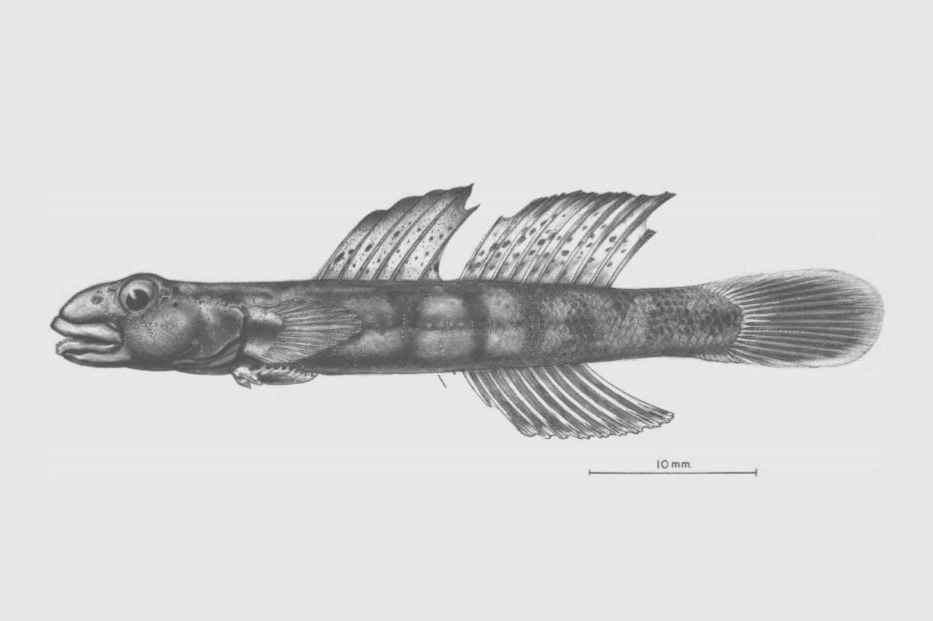Fehlmann's Sicyopus, Smilosicyopus fehlmanni (Parenti & Maciolek 1993)

Illustration of a paratype of Fehlmann's Sicyopus, CAS-SU 52025, male, 40.0 mm SL, Babelthuap Island, Palau, W. Caroline Islands. Source: Janet Roemhild Canning, Fig. 8, in Parenti & Maciolek (1993) Bulletin of Marine Science 53(3): 945-972. License: CC BY Attribution
Summary:
A cling goby with 5-7 diffuse dusky bands along the side descending only to midline in some individuals, and small black spots on the top and side of the head and on the dorsal-fin membranes.
Gravid females have a bright, blood-red belly, and juvenile females may have an orangish belly. The belly in adult males is light brown or reddish brown. In both sexes, the anterior portion of the pelvic frenum may be deep russet or the same pale tan as the remainder of the pelvic disc. This russet color appears most frequently in the barred and more heavily pigmented specimens.
Gravid females have a bright, blood-red belly, and juvenile females may have an orangish belly. The belly in adult males is light brown or reddish brown. In both sexes, the anterior portion of the pelvic frenum may be deep russet or the same pale tan as the remainder of the pelvic disc. This russet color appears most frequently in the barred and more heavily pigmented specimens.
Cite this page as:
Bray, D.J. 2023, Smilosicyopus fehlmanni in Fishes of Australia, accessed 10 Jul 2025, https://fishesofaustralia.net.au/Home/species/5218
Fehlmann's Sicyopus, Smilosicyopus fehlmanni (Parenti & Maciolek 1993)
More Info
|
Distribution |
Occurs upstream of waterfalls in a number of short steep coastal streams in the Queensland Wet Tropics. Elsewhere the species is found in the tropical, west-central Pacific, Palau to New Caledonia. Inhabits fast-flowing streams from the source to the lower reaches, often in areas with rocky substrates. |
|
Features |
Dorsal fin VI + I,8-10; Anal fin I,9-11; Pectoral fin 15; Pelvic fin 1,5; Caudal fin branched rays 12-13; Vertebrae 10 + 16 = 26; Lateral scales 22-23 rows. Predorsal scales absent; scales cycloid, present on dorsum from second dorsal-fin insertion and on body from perpendicular through posterior two or three dorsal-fin rays onto caudal-fin base; caudal scales largest. Two preopercular-canal pores. Mouth terminal, maxilla extending to below anterior portion of orbit. Lips thick, fleshy and entire. Cheeks swollen causing eye to appear oval in lateral view. Premaxillary and dentary teeth uniserial, anterior teeth weakly tricuspid, others unicuspid; anterior and posterior dentary teeth separated by one or two enlarged, caniniform teeth; no horizontal teeth on dentary. Short, fleshy tubular anterior naris about halfway between anterior margin of eye and posterior extent of upper lip; simple posterior naris anterior to eye. Head bluntly pointed in profile, head length 19-25; snout length 6-10; eye diameter 4-7; pelvic-fin length 13-15; pectoral-fin length 15-18; pre-anal length 53-60; pre-dorsal length 33-43. |
|
Colour |
Gravid females have a bright, blood-red belly; juvenile females may have an orangish belly. Belly in adult males light brown or reddish brown. In both sexes, the anterior portion of the pelvic frenum may be deep russet or the same pale tan as the remainder of the pelvic disc. This russet color appears most frequently in the barred and more heavily pigmented specimens. |
|
Biology |
After hatching, the larvae are washed downstream, and develop in estuaries or marine environments before migrating back to freshwaters. This species has a pelagic larval duration of about 54 days. |
|
Remarks |
Stream gobies have the pelvic fins highly modified into a rounded sucking disc, which has highly branched pelvic-fin rays and thickened pelvic-fin spines with a fleshy pad at the distal tip. This forms a highly effective pelvic suction cup that allows the gobies to rapidly access the upper reaches of the catchment area. |
|
Similar Species |
Differs from all other sicydiines by its unique pigmentation pattern of discrete spots on the dorsal-fin membranes, a blood-red belly in ripe females, and 5-7 diffuse dusky bands along the side descending only to midline in some individuals. |
|
Etymology |
The species is named in honour of Herman Adair Fehlmann who participated in collection of the type specimens and recognized the species as new. |
|
Species Citation |
Sicyopus fehlmanni Parenti & Maciolek, 1993, Bull. Mar. Sci. 53(3): 959, figs 4B, 7-8. Type locality: Amekaud River, northern fork, Cascade zone, Ngardmau Municipality, Babelthuap Islands, 7°33'50"N, 134°33'39"E. |
|
Author |
Bray, D.J. 2023 |
|
Resources |
Fehlmann's Sicyopus, Smilosicyopus fehlmanni (Parenti & Maciolek 1993)
References
Keith, P. 2003. Biology and ecology of amphidromous Gobiidae of the Indo - Pacific and the Caribbean regions. Journal of Fish Biology 63: 831-847 https://doi.org/10.1046/j.1095-8649.2003.00197.x
Keith, P. & Taillebois, L. 2013. Status and distribution of Smilosicyopus species (Teleostei, Gobiinae). Cybium 38(1): 69-73 https://doi.org/10.26028/cybium/2014-381-008
Parenti, L.R. & Maciolek, J.A. 1993. New sicydiine gobies from Ponape and Palau, Micronesia, with comments on systematics of the subfamily Sicydiinae (Teleostei: Gobiidae). Bulletin of Marine Science 53(3): 945-972. See ref online
Taillebois, L., Castelin, M., Ovenden, J.R., Bonillo, C. & Keith, P. 2013. Contrasting genetic structure among populations of two amphidromous fish species (Sicydiinae) in the Central West Pacific. PLoS ONE 8(10): e75465 https://doi.org/10.1371/journal.pone.0075465
Thuesen, P.A., Ebner, B.C., Larson, H.K., Keith, P., Silcock, R.M., Prince, J. & Russell, D.J. 2011. Amphidromy links a newly documented fish community of continental Australian streams, to oceanic islands of the west Pacific. PLoS ONE 6(10): e26685 https://doi.org/10.1371/journal.pone.0026685

